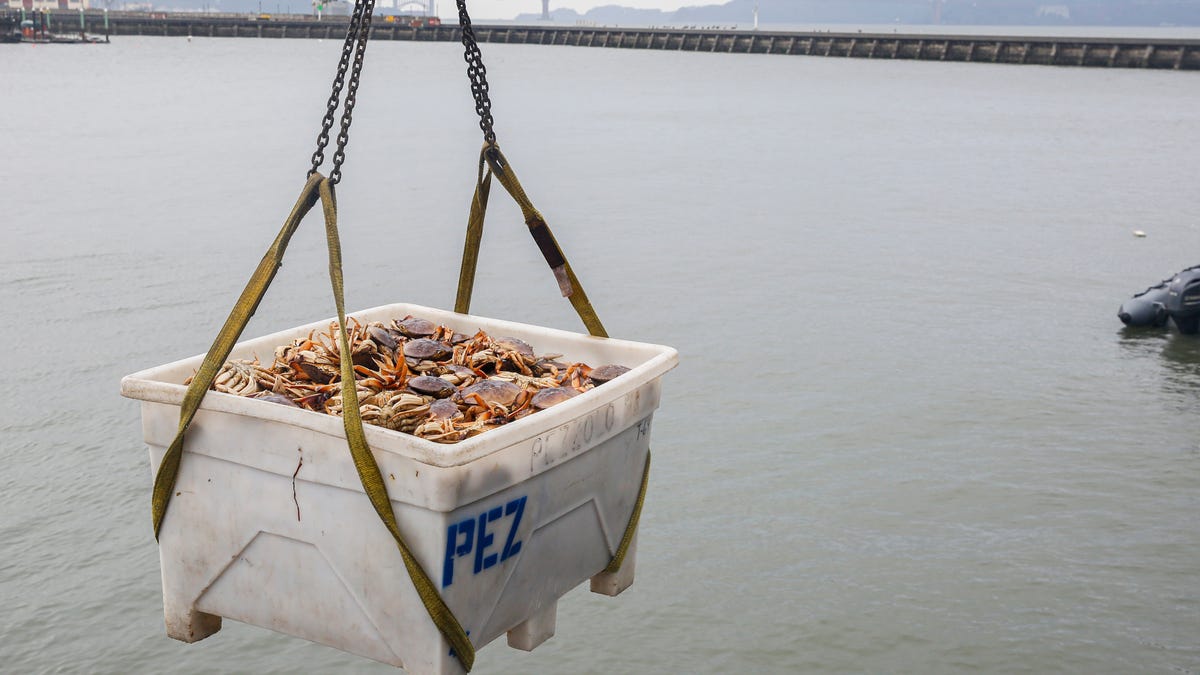Batteries Made From Crab Shells Could Power Your Future Car

A crane lifts a large tote carrying hundreds of Dungeness crabs to a family owned wholesale seafood company in San Francisco.
What's happening
Scientists developed a battery prototype that's derived from an electrolyte found in crab shells -- yes, the kind you discard after a seafood dinner.
Why it matters
Traditional rechargeable batteries, most commonly Lithium-ion, aren't easily biodegradable, and that harms the environment.
When it comes to combating the climate crisis, it's promising that we've seen a recent push for electric vehicles. Unlike standard cars, which emit clouds of fossil fuel exhaust into the atmosphere -- thereby contaminating our planet's shield and contributing to global warming -- electric versions rely on battery power, which doesn't spit out excessive pollution.
There's just one caveat. Like with all rechargeable products, the rise of electric vehicles is contingent on an uptick in battery-making.
"Vast quantities of batteries are being produced and consumed, raising the possibility of environmental problems," Liangbing Hu, director of the University of Maryland's Center for Materials Innovation, said in a press release. "For example, polypropylene and polycarbonate separators, which are widely used in Lithium-ion batteries, take hundreds or thousands of years to degrade, and add to environmental burden."
Yep. Hundreds, or thousands, of years. And that's not to mention the labor required to construct those particular batteries in the first place, as well as controversy surrounding human rights violations that arise in places where components of the batteries, like cobalt, are harvested. Yet really,those Lithium-ion batteries are everywhere. In fact, you're probably holding one right now if you're reading this article with a mobile phone. They're also often paired with solar panels that collect sunlight to store eco-friendly power -- maybe taking a little bit of the "eco-friendly" title away from those navy blue rectangles.
OK, but this is all to say that Hu might have an interesting solution to the battery conundrum.
In a paper published Thursday in the journal Matter, Hu and fellow researchers present their invention of a battery that's much more easily biodegradable than Lithium-ion power sources.
The weird part? It's made out of crab shells.
Some discarded crab shells, filled to the brim with chitosin.
Um, did you say crab shells?
You know how when you try to load a TV remote or Xbox controller with AA batteries, there's the whole plus and minus thing to worry about?
Basically, this is because batteries work by using a special substance called an electrolyte to shuffle ions, or charged particles, back and forth between those negative and positive terminals. It's important to get the (+) and (-) in the right position.
That electrolyte can be a multitude of different mediums, but according to the new study's researchers, many batteries use flammable or corrosive chemicals for this function. Chemicals that aren't easily biodegradable. In contrast, for their battery Hu and colleagues called on a gel electrolyte that's found in a biological material named chitosan. Chitosan is readily biodegradable.
In this diagram, you can see how the chitosan gets converted to a battery and eventually biodegrades.
"Chitosan is a derivative product of chitin," Hu said. "Chitin has a lot of sources, including the cell walls of fungi, the exoskeletons of crustaceans, and squid pens." But the most abundant source of chitosan, according to Hu, is located in those crustacean exoskeletons. Things like pinkish shrimp tails, crimson lobster carapaces and, of course, crab shells.
And you know where those exoskeletons can be found? "Seafood waste," Hu said. "You can find it on your table."
In a way, this aspect of the team's prototype addresses two problems at once. According to a 2015 study in Nature, some 6 million to 8 million tons of waste crab, shrimp and lobster shells are produced globally. I mean, think about how the meat of a crab accounts for only around 40% of its mass. That's bound to create quite a lot of food waste.
Those shells, the report continues, are often just dumped into a landfill or the sea -- a costly form of disposal that can add up to more than $100 per ton and one that's bad for the environment because landfills indirectly contribute to harmful gas emissions themselves.
So, from the standpoint of producing biodegradable batteries, imagine if all those expensive-to-throw-away shells could be repurposed into something useful and helpful for protecting our planet?
Leveling-up zinc batteries
According to the team's new study, the chitosan used in its battery prototypes broke down completely within five months, leaving behind a metal component called zinc -- rather than lead or lithium like standard batteries -- which is actually recyclable.
A sort of time-lapse photo set that shows how the team's battery material degrades into the soil after five months.
The prototype also had an energy efficiency of 99.7% after 1,000 cycles, meaning it's a viable option for storing wind or solar energy in power grids. That's a big improvement for the world of zinc batteries, because even though these power storage options aren't exactly new, they've been notorious for having a pretty mid efficiency. The researchers say the crab shell-derived ingredient might be the missing piece that can take them to the next level.
As of now, Hu says that including chitosan as an electrolyte in a battery means about two thirds of the battery can be biodegraded, but going forward, the team hopes to tackle that remaining one third. "In the future, I hope all components in batteries are biodegradable," Hu said. "Not only the material itself but also the fabrication process of biomaterials."

